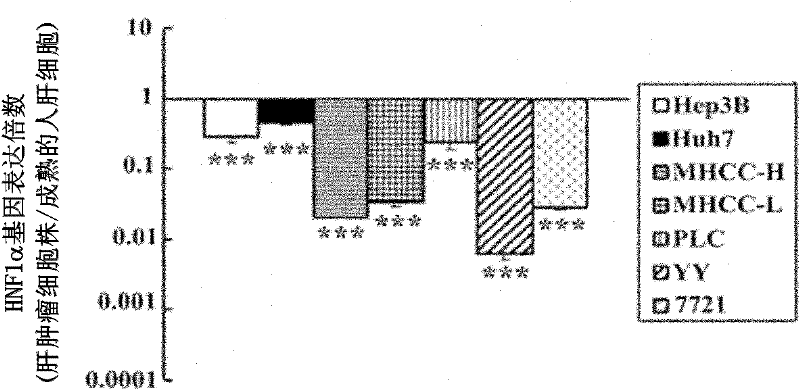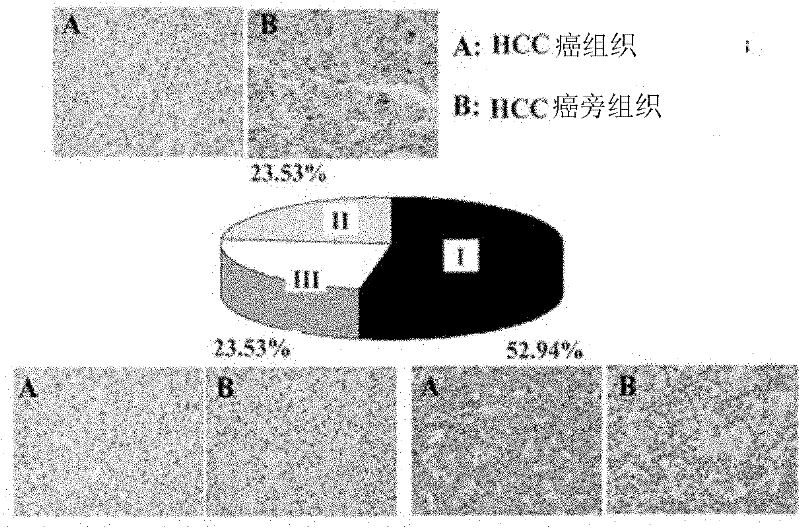Method for treating human malignant solid tumor by using hepatocyte nuclear factor-1alpha
A liver cell nuclear factor and solid tumor technology, applied in the field of solid tumor treatment, can solve the problems of unscreened differentiation therapy drugs or proteins, inability to differentiate tumors, and reduce tumorigenesis of cancer cells
- Summary
- Abstract
- Description
- Claims
- Application Information
AI Technical Summary
Problems solved by technology
Method used
Image
Examples
Embodiment 1
[0089] Detection of HNF1α gene expression in human liver tumor cell line by Realtime RT-PCR
[0090] 1. The commercially available conventional liver tumor cell lines Huh-7, Hep3B, MHCC-H, MHCC-L, PLC, YY, and 7721 were all mixed with 5×10 5 Inoculated in a six-well plate per plate, cultivated with fresh culture medium containing 10% fetal bovine serum, extracted cellular RNA the next day, and measured OD with a spectrophotometer 260 Values were formulated into working concentrations (1 μg / μl and 0.1 μg / μl), and RNA integrity was detected by 1% agarose gel electrophoresis.
[0091] 2. Realtime RT-PCR: Take 4 μg RNA, 2 μl Random primer, and add DEPC water to 33 μl, set at 70°C for 5 minutes, and after 0°C for 5 minutes, add 10 μl 5×Buffer, 3 μl dNTP, 2 μl RNA reverse transcriptase and 2 μl RNase After mixing the inhibitors, place at 37°C for 1.5h to obtain the reverse transcription product. After diluting the reverse transcription product, take 1 μl as a template for Realti...
Embodiment 2
[0096] Realtime RT-PCR and immunohistochemical detection of HNF1α gene and protein expression in human liver cancer tissues and adjacent tissues
[0097] 1. Realtime RT-PCR: Trizol method to extract RNA from human liver cancer and paracancerous tissues, and measure its OD with a spectrophotometer 260 Values were formulated into working concentrations (1 μg / μl and 0.1 μg / μl), and RNA integrity was detected by 1% agarose gel electrophoresis. 4 μg of RNA was taken for reverse transcription and Realtime PCR amplification (reverse transcription reaction, Realtime PCR reaction conditions and primer sequences were the same as above).
[0098] The results showed that: Among the 11 pairs of human liver cancer tissues / adjacent tissues, the expression of HNF1α in 7 cases (63.64%) of liver cancer tissues was lower than that of the adjacent tissues.
[0099] 2. Immunohistochemistry: Human liver cancer and paracancerous tissue wax block 4mm serial section, baked in 60 ℃ oven for 30min an...
Embodiment 3
[0102] Detection of HNF1α gene and protein expression in liver tissue of rat primary liver cancer model induced by DEN by immunohistochemical method
[0103] 1. DEN was injected intraperitoneally at 70 mg / kg to prepare rat primary liver cancer models. During the modeling process, the rats were sacrificed before modeling and at 10w, 18w, and 22w after modeling.
[0104] 2. Take rat liver tissue, fix it overnight in 10% neutral formalin, trim the tissue into 1.0×1.0×0.5cm block, soak in running water for 12h, ethanol gradient (50%-75%-80%-95% - absolute ethanol) dehydration, xylene transparent and dipped in wax to make tissue wax block. Immunohistochemical staining was performed after serial sectioning of wax blocks.
[0105] The results showed that the expression of HNF1α in rat liver tissue was gradually weakened with the prolongation of modeling time, and the expression of HNF1α in liver cancer tissue was the weakest.
PUM
 Login to View More
Login to View More Abstract
Description
Claims
Application Information
 Login to View More
Login to View More - R&D
- Intellectual Property
- Life Sciences
- Materials
- Tech Scout
- Unparalleled Data Quality
- Higher Quality Content
- 60% Fewer Hallucinations
Browse by: Latest US Patents, China's latest patents, Technical Efficacy Thesaurus, Application Domain, Technology Topic, Popular Technical Reports.
© 2025 PatSnap. All rights reserved.Legal|Privacy policy|Modern Slavery Act Transparency Statement|Sitemap|About US| Contact US: help@patsnap.com



